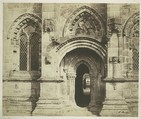Roslin Chapel, South Porch
Roger Fenton British
Not on view
Roger Fenton is a seminal figure in the history of British photography as much for his advocacy of the highest standards for the new medium through the founding of the Photographic Society in London in 1853 as for his own artistic achievements. In his early years he pursued, simultaneously, studies in both law and painting in London and in Paris. As a photographer he achieved public recognition mainly as an accredited photographer of the Crimean War, in 1855. Fenton was very much aware of the technical advances being made in France. He was also impressed by the concern of the French government for the preservation of historic sites, and the commissioning, in 1851, of photographic surveys of the country's architectural heritage. As such patronage did not exist in Great Britain, Fenton made his architectural studies on his own initiative, traveling extensively throughout England, Scotland, and Wales.
Fenton photographed Rosslyn Chapel, a site celebrated in verse by such poets as Sir Walter Scott, Wordsworth, and Lord Byron, during his first photographic expedition to Scotland. Erected in 1466 by William St. Clair, earl of Rosslyn, the chapel, a striking example of Late Gothic ornamentation, is the choir of a collegial church that was never completed. In Fenton's image the wall rises as a forbidding mass, abruptly blocking one's path; the narrow portal, however, allows the eye to enter and bore through the dark interior before reaching the sunlit countryside beyond. In this interplay between mass and space, dark and light, Fenton brings to his picture the very tensions of the architecture he describes.
The print bears the photographer's rare signature.
Due to rights restrictions, this image cannot be enlarged, viewed at full screen, or downloaded.

